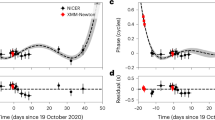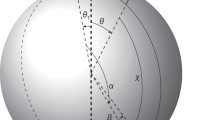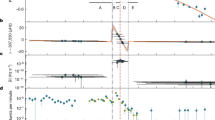Abstract
The lack of isolated X-ray pulsars with spin periods longer than 12 s raises the question of where the population of evolved high-magnetic-field neutron stars has gone. Unlike canonical radiopulsars, X-ray pulsars are not subject to physical limits to the emission mechanism nor observational biases against the detection of sources with longer periods. Here we show that a highly resistive layer in the innermost part of the crust of neutron stars naturally limits the spin period to a maximum value of about 10–20 s. This highly resistive layer is expected if the inner crust is amorphous and heterogeneous in nuclear charge, possibly owing to the existence of a nuclear ‘pasta’ phase. Our findings suggest that the maximum period of isolated X-ray pulsars may be the first observational evidence for an amorphous inner crust, whose properties can be further constrained by future X-ray timing missions combined with more detailed models.
This is a preview of subscription content, access via your institution
Access options
Subscribe to this journal
Receive 12 print issues and online access
$209.00 per year
only $17.42 per issue
Buy this article
- Purchase on Springer Link
- Instant access to full article PDF
Prices may be subject to local taxes which are calculated during checkout




Similar content being viewed by others
References
Demorest, P. B., Pennucci, T., Ransom, S. M., Roberts, M. S. E. & Hessels, J. W. T. A two-solar-mass neutron star measured using Shapiro delay. Nature 467, 1081–1083 (2010).
Van Kerkwijk, M. H., Breton, R. P. & Kulkarni, S. R. Evidence for a massive neutron star from a radial-velocity study of the companion to the black-widow pulsar PSR B1957+20. Astrophys. J. 728, 95–102 (2011).
Shternin, P. S., Yakovlev, D. G., Heinke, C. O., Ho, W. C. G. & Patnaude, D. J. Cooling neutron star in the Cassiopeia A supernova remnant: Evidence for superfluidity in the core. Mon. Not. R. Astron. Soc. 412, L108–L112 (2011).
Steiner, A. W., Lattimer, J. M. & Brown, E. F. The equation of state from observed masses and radii of neutron stars. Astrophys. J. 722, 33–54 (2010).
Mereghetti, S. The strongest cosmic magnets: Soft γ-ray repeaters and anomalous X-ray pulsars. Astronom. Astrophys. Rev. 15, 225–287 (2008).
Gavriil, F. P., Kaspi, V. M. & Woods, P.M. Magnetar-like X-ray bursts from an anomalous X-ray pulsar. Nature 419, 142–144 (2002).
Palmer, D. M. et al. A giant γ-ray flare from the magnetar SGR 1806-20. Nature 434, 1107–1109 (2005).
Camilo, F. et al. Transient pulsed radio emission from a magnetar. Nature 442, 892–895 (2006).
Duncan, R. C. & Thompson, C. Formation of very strongly magnetized neutron stars—Implications for γ-ray bursts. Astrophys. J. 392, L9–L13 (1992).
Kaspi, V. M. Grand unification of neutron stars. Proc. Natl Acad. Sci. USA 107, 7147–7152 (2010).
Psaltis, D. & Miller, M. C. Implications of the narrow period distribution of anomalous X-Ray pulsars and soft γ-ray repeaters. Astrophys. J. 578, 325–329 (2002).
Colpi, M., Geppert, U. & Page, D. Period clustering of the anomalous X-Ray pulsars and magnetic field decay in magnetars. Astrophys. J. 529, L29–L32 (2000).
Rea, N. et al. A low-magnetic-field soft γ repeater. Science 330, 944–946 (2010).
Turolla, R., Zane, S., Pons, J. A., Esposito, P. & Rea, N. Is SGR 0418+5729 indeed a waning magnetar? Astrophys. J. 740, 105–111 (2011).
Rea, N. et al. A new low magnetic field magnetar: The 2011 outburst of swift J1822.3-1606. Astrophys. J. 754, 27–40 (2012).
Goldreich, P. & Reisenegger, A. Magnetic field decay in isolated neutron stars. Astrophys. J. 395, 250–258 (1992).
Cumming, A., Arras, P. & Zweibel, E. Magnetic field evolution in neutron star crusts due to the hall effect and ohmic decay. Astrophys. J. 609, 999–1017 (2004).
Chamel, N. & Haensel, P. Physics of neutron star crusts. Living Rev. Relat. 11, 10 (2008).
Anderson, P. W. & Itoh, N. Pulsar glitches and restlessness as a hard superfluidity phenomenon. Nature 256, 25–27 (1975).
Strohmayer, T. E. & Watts, A. L. The 2004 hyperflare from SGR 1806-20: Further evidence for global torsional vibrations. Astrophys. J. 653, 593–601 (2006).
Brown, E. F. & Cumming, A. Mapping crustal heating with the cooling light curves of quasi-persistent transients. Astrophys. J. 698, 1020–1032 (2009).
Pons, J. A. & Geppert, U. Magnetic field dissipation in neutron star crusts: From magnetars to isolated neutron stars. Astron. Astrophys. 470, 303–315 (2007).
Viganò, D., Pons, J. A. & Miralles, J. A. A new code for the Hall-driven magnetic evolution of neutron stars. Comput. Phys. Comm. 183, 2042–2053 (2012).
Ravenhall, D. G., Pethick, C. J. & Wilson, J. R. Structure of matter below nuclear saturation density. Phys. Rev. Lett. 50, 2066–2069 (1983).
Horowitz, C. J., Pérez-Garcı´a, M. A., Berry, D. K. & Piekarewicz, J. Dynamical response of the nuclear pasta in neutron star crusts. Phys. Rev. C 72, 035801 (2005).
Horowitz, C. J. & Berry, D. K. Shear viscosity and thermal conductivity of nuclear pasta. Phys. Rev. C 78, 035806 (2008).
Watanabe, G., Iida, K. & Sato, K. Thermodynamic properties of nuclear pasta in neutron star crusts. Nucl. Phys. A 676, 455–473 (2000).
Sotani, H. Constraints on pasta structure of neutron stars from oscillations in giant flares. Mon. Not. R. Astron. Soc. 417, L70–L73 (2011).
Gearheart, M., Newton, W.G., Hooker, J. & Li, B-An. Upper limits on the observational effects of nuclear pasta in neutron stars. Mon. Not. R. Astron. Soc. 418, 2343–2349 (2011).
Jones, P. B. Disorder resistivity of solid neutron-star matter. Phys. Rev. Lett. 93, 221101 (2004).
Jones, P. B. Heterogeneity of solid neutron-star matter: Transport coefficients and neutrino emissivity. Mon. Not. R. Astron. Soc. 351, 956–966 (2004).
Magierski, P. & Heenen, P. H. Structure of the inner crust of neutron stars: Crystal lattice or disordered phase? Phys. Rev. C 65, 045804 (2002).
Horowitz, C. J. & Berry, D. K. Structure of accreted neutron star crust. Phys. Rev. C 79, 065803 (2009).
Horowitz, C. J., Caballero, O. L. & Berry, D. K. Thermal conductivity and phase separation of the crust of accreting neutron stars. Phys. Rev. E 79, 026103 (2009).
Hughto, J., Schneider, A. S., Horowitz, C. J. & Berry, D. K. Diffusion in Coulomb crystals. Phys. Rev. E 84, 016401 (2011).
Daligault, J. & Gupta, S. Electron-ion scattering in dense multi-component plasmas: Application to the outer crust of an accreting neutron star. Astrophys. J. 703, 994–1011 (2009).
Pons, J. A., Miralles, J. A. & Geppert, U. Magneto-thermal evolution of neutron stars. Astron. Astrophys. 496, 207–216 (2009).
Aguilera, D. N., Pons, J. A. & Miralles, J. A. The impact of magnetic field on the thermal evolution of neutron stars. Astrophys. J. 673, L167–L170 (2008).
Li, J., Spitkovsky, A. & Tchekhovskoy, A. Resistive solutions for pulsar magnetospheres. Astrophys. J. 746, 60 (2012).
Ho, W. C. G & Andersson, N. Rotational evolution of young pulsars due to superfluid decoupling. Nature Phys. 8, 787–789 (2012).
Feroci, M. et al. The large observatory for X-ray timing (LOFT). Exp. Astronom. 34, 415–444 (2012).
Acknowledgements
This work has been supported by the grants AYA 2010-21097-C03-02, AYA2012-39303, SGR2009-811, TW2010005 and iLINK 2011-0303. N.R. is supported by a Ramon y Cajal Research Fellowship and D.V. by the Prometeo/2009/103 grant.
Author information
Authors and Affiliations
Contributions
J.A.P. and D.V. contributed to developing the model, performed the calculations and wrote the manuscript. N.R. contributed to writing the manuscript and selected and checked the observational data.
Corresponding author
Ethics declarations
Competing interests
The authors declare no competing financial interests.
Rights and permissions
About this article
Cite this article
Pons, J., Viganò, D. & Rea, N. A highly resistive layer within the crust of X-ray pulsars limits their spin periods. Nature Phys 9, 431–434 (2013). https://doi.org/10.1038/nphys2640
Received:
Accepted:
Published:
Issue Date:
DOI: https://doi.org/10.1038/nphys2640
This article is cited by
-
Analytic multi-Baryonic solutions in the SU(N)-Skyrme model at finite density
Journal of High Energy Physics (2021)
-
Relativistic fluid dynamics: physics for many different scales
Living Reviews in Relativity (2021)
-
Magnetic, thermal and rotational evolution of isolated neutron stars
Living Reviews in Computational Astrophysics (2019)
-
Calculation of the transport coefficients of the nuclear pasta phase
Journal of Astrophysics and Astronomy (2018)
-
Superfluidity and Superconductivity in Neutron Stars
Journal of Astrophysics and Astronomy (2017)



